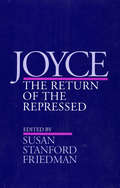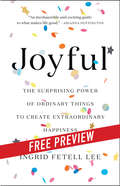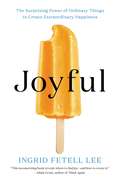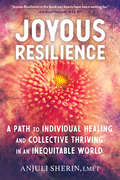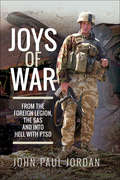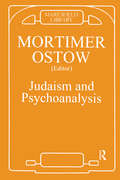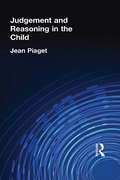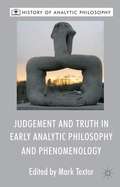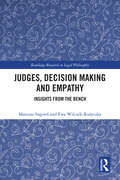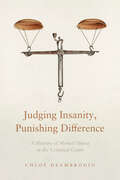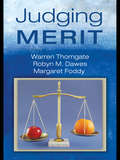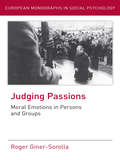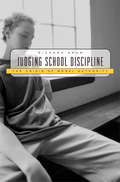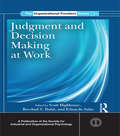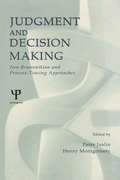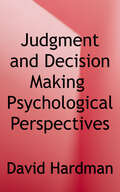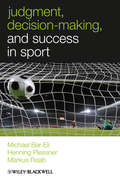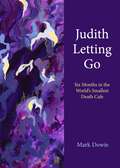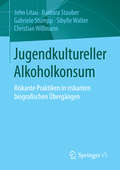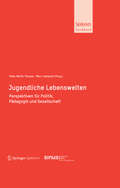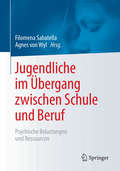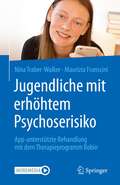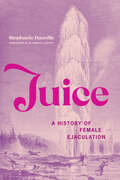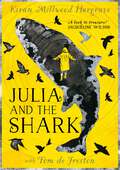- Table View
- List View
Joyce: The Return of the Repressed
Did James Joyce, that icon of modernity, spearhead the dismantling of the Cartesian subject? Or was he a supreme example of a modern man forever divided and never fully known to himself? This volume reads the dialogue of contradictory cultural voices in Joyce’s works—revolutionary and reactionary, critical and subject to critique, marginal and central. It includes ten essays that identify repressed elements in Joyce’s writings and examine how psychic and cultural repressions persistently surface in his texts. Contributors include Joseph A. Boone, Marilyn L. Brownstein, Jay Clayton, Laura Doyle, Susan Stanford Friedman, Christine Froula, Ellen Carol Jones, Alberto Moreirias, Richard Pearce, and Robert Spoo.
Joyful: The Surprising Power of Ordinary Things to Create Extraordinary Happiness
by Ingrid Fetell LeeDesigner and TED star Ingrid Fetell Lee explains how to cultivate a happier, healthier life by making small changes to your surroundings. Have you ever wondered why we stop to watch the orange glow that arrives before sunset, or why we flock to see cherry blossoms bloom in spring? Is there a reason that people -- regardless of gender, age, culture, or ethnicity -- are mesmerized by baby animals, and can't help but smile when they see a burst of confetti or a cluster of colorful balloons. We are often made to feel that the physical world has little or no impact on our inner joy. Increasingly, experts urge us to find balance and calm by looking inward -- through mindfulness or meditation -- and muting the outside world. But what if the natural vibrancy of our surroundings is actually our most renewable and easily accessible source of joy? In Joyful, designer Ingrid Fetell Lee explores how the seemingly mundane spaces and objects we interact with every day have surprising and powerful effects on our mood. Drawing on insights from neuroscience and psychology, she explains why one setting makes us feel anxious or competitive, while another fosters acceptance and delight -- and, most importantly, she reveals how we can harness the power of our surroundings to live fuller, healthier, and truly joyful lives.
Joyful: The Surprising Power of Ordinary Things to Create Extraordinary Happiness
by Ingrid Fetell LeeDesigner and TED star Ingrid Fetell Lee explains how to cultivate a happier, healthier life by making small changes to your surroundings. Have you ever wondered why we stop to watch the orange glow that arrives before sunset, or why we flock to see cherry blossoms bloom in spring? Is there a reason that people -- regardless of gender, age, culture, or ethnicity -- are mesmerized by baby animals, and can't help but smile when they see a burst of confetti or a cluster of colorful balloons. We are often made to feel that the physical world has little or no impact on our inner joy. Increasingly, experts urge us to find balance and calm by looking inward -- through mindfulness or meditation -- and muting the outside world. But what if the natural vibrancy of our surroundings is actually our most renewable and easily accessible source of joy? In Joyful, designer Ingrid Fetell Lee explores how the seemingly mundane spaces and objects we interact with every day have surprising and powerful effects on our mood. Drawing on insights from neuroscience and psychology, she explains why one setting makes us feel anxious or competitive, while another fosters acceptance and delight -- and, most importantly, she reveals how we can harness the power of our surroundings to live fuller, healthier, and truly joyful lives.
Joyous Resilience: A Path to Individual Healing and Collective Thriving in an Inequitable World
by Anjuli SherinAn intersectional guide to building resilience and reclaiming joyWith so much information available on how to build resilience--from meditation, exercise, and time in nature, to the latest neuroscience-backed studies--have you ever wondered what's holding you back? If you commit to self-care but find yourself exhausted, unhappy, or anxious, do you wonder what's missing?The fact is, we are all navigating an exhausting, disconnecting, do-more-buy-more culture that disproportionately harms those with marginalized identities and leads us to believe that our thriving depends solely on individual effort. Mainstream wellness culture doesn't account for the ways that social oppression and economic injustice intersect to make resilience diffi cult for many of us to access in the first place. So, where do we begin? In this warm and accessible guide, Pakistani American therapist Anjuli Sherin provides a healing path to make thriving possible for everyone. Through compelling client stories and reflective exercises, she offers a culturally informed, body -centered model that shows us how cultivating self-nurturance, healthy boundaries, pleasure, and a soulful connection to the natural world can give us the generative energy needed to heal individual and collective trauma and shape our world from an inner magic called joyous resilience.
Joys of War: From the Foreign Legion, the SAS and into Hell with PTSD
by John-Paul JordanA Special Forces veteran and former Legionnaire tells of his military adventures—and of the personal battle that followed him home. In war, John-Paul Jordan was the first to batter down the door, whether he was facing bullets or bombs. In the wake of the 9/11 attacks, the young Irishman set off to join the French Foreign Legion. He would go on to provide security in Iraq, serve his country in Afghanistan, and protect journalists on the front line in Libya. He was decorated for his leadership and bravery—but his biggest fight would come after he left the battlefield. In this memoir he recounts the camaraderie, action, and danger he experienced—and how he later found himself of prisoner of war to PTSD. Dehumanized by the professionals he turned to for help, this Special Forces veteran and former Legionnaire was brought to his knees. His marriage was over; his home was lost. In isolation, his world unraveled, and the seeds of destruction had been well and truly sown. Knowing he would never see military action again and faced with the realization of the war raging within him in the spiral of PTSD, John-Paul felt condemned as a man. But, on April 1, 2016, he surrendered. He asked for help . . . and found the answers within. His story is a testament to the strength of the human spirit: to get back up and to lead from the front. He did not go through all that just to go through all that. This is the story of his return to freedom and joy. Buckle up, because this veteran doesn&’t do anything in half measures.
Judaism and Psychoanalysis
by Mortimer OstowIs psychoanalysis a "Jewish science"? Ten essays contributed by the editor and distinguished scholars explore the Jewishness of psychoanalysis, its origins in the Jewish situation of late nineteenth century Europe, Freud's Jewishness and the Jewishness of his early colleagues. They also exemplify what the psychoanalytic approach can contribute to the study of Judaism. Clinical studies illuminate the issue of Jewish identity and psychological significance of the bar mitzvah experience. Theoretical essays throw light on Jewish history, Jewish social and communal behavior, Jewish myths and legends, religious ideas and thoughts.What are the major determinants of Jewish identity? What is the role of Jewish education in establishing and maintaining Jewish identity? What does the Midrash tell us about the meaning of anxiety to the traditional Jew, and how does Judaism attempt to deal with anxiety? What strategies have Jews used to survive an anti-Jewish world? Under what circumstances has the compliant posture of Johanen ben Zakkai been celebrated, and under what circumstances the defiance of the martyrs of Massada?
Judgement and Reasoning in the Child
by Jean PiagetOver a period of six decades, Jean Piaget conducted a program of naturalistic research that has profoundly affected our understanding of child development.
Judgement and Truth in Early Analytic Philosophy and Phenomenology
by Mark TextorWhat is judgement? is a question that has exercised generations of philosophers. Early analytic philosophers (Frege, Russell and Wittgenstein) and phenomenologists (Brentano, Husserl and Reinach) changed how philosophers think about this question. This book explores and assesses their contributions and help us to retrace their steps.
Judges, Decision Making and Empathy: Insights from the Bench (Routledge Research in Legal Philosophy)
by Mateusz Stępień Ewa Wilczek-RużyczkaThis book presents empirical research uncovering the views and experiences of Polish judges regarding the utilization of empathy in their work. Although there is growing interest in the role of empathy in judicial decision-making, there is little research on how judges themselves approach this issue. This volume offers an alternative to the usual focus on common law jurisdictions. It adopts a perspective that underscores the impact of professional pressures on judges’ empathic abilities, leading to a form of "empathy labor" influenced by the unique characteristics of the judicial profession. It offers an in-depth examination of judges’ opinions, collected through an empirical study involving in-depth interviews. The narrative delves into real cases and judicial behaviors discussed by judges, providing reference to relevant literature from other jurisdictions. The core finding of the study reveals that while judges may differ in their approaches to empathy in a judicial context, many of their practices and strategies can be linked to empathy-like phenomena. The findings also substantiate the claim that empathy used by judges is not the same as judicial empathy, which covers empathic abilities integrated into performing the judicial role. This applied theoretical perspective of "empathy labor" offers an intriguing view of how the occupational context influences judges’ empathic inclinations throughout their careers. In addition to demonstrating how judges understand the role of empathy in their work, the book outlines a scenario for empathy training based on their experiences and expectations. Presenting an original approach to studying the role of empathy in judicial decision making, the book will be of interest to academics and researchers working in the areas of philosophy of law, legal theory, sociology of law, psychology of law, and emotions studies.
Judging Insanity, Punishing Difference: A History of Mental Illness in the Criminal Court (The Cultural Lives of Law)
by Chloé DeambrogioIn Judging Insanity, Punishing Difference, Chloé Deambrogio explores how developments in the field of forensic psychiatry shaped American courts' assessments of defendants' mental health and criminal responsibility over the course of the twentieth century. During this period, new psychiatric notions of the mind and its readability, legal doctrines of insanity and diminished culpability, and cultural stereotypes about race and gender shaped the ways in which legal professionals, mental health experts, and lay witnesses approached mental disability evidence, especially in cases carrying the death penalty. Using Texas as a case study, Deambrogio examines how these medical, legal, and cultural trends shaped psycho-legal debates in state criminal courts, while shedding light on the ways in which experts and lay actors' interpretations of "pathological" mental states influenced trial verdicts in capital cases. She shows that despite mounting pressures from advocates of the "rehabilitative penology," Texas courts maintained a punitive approach towards defendants allegedly affected by severe mental disabilities, while allowing for moralized views about personalities, habits, and lifestyle to influence psycho-legal assessments, in potentially prejudicial ways.
Judging Merit
by Robyn M. Dawes Warren Thorngate Margaret FoddyMerit-based tests and contests have become popular methods for allocating rewards – from trophies to contracts, jobs to grants, admissions to licenses. With origins in jurisprudence, methods of rewarding merit seem fairer than those rewarding political or social connections, bribery, aggression, status, or wealth. Because of this, merit-based competitions are well-suited to the societal belief that people should be rewarded for what they know or do, and not for who they know or are; however, judging merit is rarely an easy task – it is prone to a variety of biases and errors. Small biases and errors, especially in large competitions, can make large differences in who or what is rewarded. It is important, then, to learn how to spot flaws in procedures for judging merit and to correct them when possible. Based on over 20 years of theory and research in human judgment, decision making and social psychology, this unique book brings together for the first time what is known about the processes and problems of judging merit and their consequences. It also provides practical suggestions for increasing the fairness of merit-based competitions, and examines the future and limits of these competitions in society.
Judging Passions: Moral Emotions in Persons and Groups (European Monographs in Social Psychology)
by Roger Giner-SorollaShortlisted for the British Psychological Society Book Award (Academic Monograph category) 2014! A CHOICE Outstanding Academic Title 2013! Psychological research shows that our emotions and feelings often guide the moral decisions we make about our own lives and the social groups to which we belong. But should we be concerned that our important moral judgments can be swayed by "hot" passions, such as anger, disgust, guilt, shame and sympathy? Aren’t these feelings irrational and counterproductive? Using a functional conflict theory of emotions (FCT), Giner-Sorolla proposes that each emotion serves a number of different functions, sometimes inappropriately, and that moral emotions in particular are intimately tied to problems faced by the individuals in a group, and by groups interacting with each other. Specifically, the author suggests that these emotions help us, as individuals and group members, to: Appraise developments in the environment Learn through association Regulate our own behavior Communicate convincingly with others. Drawing on extensive research, including many studies from the author’s own lab, this book shows why emotions work to encourage reasonable moral behaviour, and why they sometimes fail. This is the first single-authored volume in the field of psychology dedicated to a separate examination of the major moral and positive emotions. As such, the book is ideal reading for researchers, postgraduates and undergraduates of social psychology, sociology, philosophy and politics.
Judging School Discipline: The Crisis of Moral Authority
by Richard ArumReprimand a class comic, restrain a bully, dismiss a student for brazen attire--and you may be facing a lawsuit, costly regardless of the result. This reality for today's teachers and administrators has made the issue of school discipline more difficult than ever before--and public education thus more precarious. This is the troubling message delivered in Judging School Discipline, a powerfully reasoned account of how decades of mostly well-intended litigation have eroded the moral authority of teachers and principals and degraded the quality of American education. Judging School Discipline casts a backward glance at the roots of this dilemma to show how a laudable concern for civil liberties forty years ago has resulted in oppressive abnegation of adult responsibility now. In a rigorous analysis enriched by vivid descriptions of individual cases, the book explores 1,200 cases in which a school's right to control students was contested. Richard Arum and his colleagues also examine several decades of data on schools to show striking and widespread relationships among court leanings, disciplinary practices, and student outcomes; they argue that the threat of lawsuits restrains teachers and administrators from taking control of disorderly and even dangerous situations in ways the public would support.
Judgment and Decision Making as a Skill
by Michael R. Waldmann Mandeep K. Dhami Anne SchlottmannThis book presents a comprehensive review of emerging theories and research on the dynamic nature of human judgment and decision making (JDM). Leading researchers in the fields of JDM, cognitive development, human learning and neuroscience discuss short-term and long-term changes in JDM skills. The authors consider how such skills increase and decline on a developmental scale in children, adolescents and the elderly; how they may be learned; and how JDM skills can be improved and aided. In addition, beyond these behavioral approaches to understanding JDM as a skill, the book provides fascinating new insights from recent evolutionary and neuropsychological approaches. The authors identify opportunities for future research on the acquisition and changing nature of JDM. In a concluding chapter, eminent past presidents of the Society for Judgment and Decision Making provide personal reflections and perspectives on the notion of JDM as a dynamic skill.
Judgment and Decision Making at Work (SIOP Organizational Frontiers Series)
by Scott Highhouse Eduardo Salas Reeshad S. DalalEmployees are constantly making decisions and judgments that have the potential to affect themselves, their families, their work organizations, and on some occasion even the broader societies in which they live. A few examples include: deciding which job applicant to hire, setting a production goal, judging one’s level of job satisfaction, deciding to steal from the cash register, agreeing to help organize the company’s holiday party, forecasting corporate tax rates two years later, deciding to report a coworker for sexual harassment, and predicting the level of risk inherent in a new business venture. In other words, a great many topics of interest to organizational researchers ultimately reduce to decisions made by employees. Yet, numerous entreaties notwithstanding, industrial and organizational psychologists typically have not incorporated a judgment and decision-making perspective in their research. The current book begins to remedy the situation by facilitating cross-pollination between the disciplines of organizational psychology and decision-making. The book describes both laboratory and more “naturalistic” field research on judgment and decision-making, and applies it to core topics of interest to industrial and organizational psychologists: performance appraisal, employee selection, individual differences, goals, leadership, teams, and stress, among others. The book also suggests ways in which industrial and organizational psychology research can benefit the discipline of judgment and decision-making. The authors of the chapters in this book conduct research at the intersection of organizational psychology and decision-making, and consequently are uniquely positioned to bridging the divide between the two disciplines.
Judgment and Decision Making: Neo-brunswikian and Process-tracing Approaches
by Henry Montgomery Peter JuslinResearch on human judgment and decision making has been strongly guided by a normative/descriptive approach, according to which human decision making is compared to the normative models provided by decision theory, statistics, and the probability calculus. A common empirical finding has been that human behavior deviates from the prescriptions by normative models--that judgments and decisions are subject to cognitive biases. It is interesting to note that Swedish research on judgment and decision making made an early departure from this dominating mainstream tradition, albeit in two different ways. The Neo-Brunswikian research highlights the relationship between the laboratory task and the adaptation to a natural environment. The process-tracing approach attempts to identify the cognitive processes before, during, and after a decision. This volume summarizes current Swedish research on judgment and decision making, covering topics, such as dynamic decision making, confidence research, the search for dominance structures and differentiation, and social decision making.
Judgment and Decision Making: Psychological Perspectives (BPS Textbooks In Psychology Series)
by David HardmanThis is a refreshingly accessible text that explores the wide variety of ways people make judgments. It examines assessments of probability, frequency, and causation; as well as how decisions are rendered under conditions of risk and uncertainty. Topics covered include dynamic, every day, and group decision making; individual differences; and the nature of mind and brain in relation to judgment and decision making. <p><p>Offering up-to-date theoretical coverage, including perspectives from evolutionary psychology and neuroscience, this volume has everything a psychology student needs for BPS accreditation, whilst drawing out the practical applications for non-psychology students with plentiful examples from business, economics, sport, law, and medicine. The latest addition to the BPS Textbooks in Psychology series, this thorough text provides a succinct, reader-friendly account of the field of judgment and decision making.
Judgment, Decision-making and Success in Sport
by Henning Plessner Michael Bar-Eli Markus RaabJudgment, Decision-Making and Success in Sport presents a thorough overview and assessment of the study of Judgment and Decision-Making (JDM) in sports psychology, and represents an important source of information for those interested in the possible causes and reasons for success and failure in sport.The only book to apply the principles of JDM to sportApplies theory to practice by looking at problems of athletes, coaches, and referees and providing recommendations for dealing with themOffers an overview of current JDM researchUseful for psychologists, physical education teachers, sports scientists, and researchers in this field
Judith Letting Go: Six Months in the World's Smallest Death Cafe
by Mark DowieAn old man learns how to die from a poet facing deathFor the entire six months that Mark Dowie became friends with Judith Tannenbaum, they both knew she was going to die. In fact, for most of that time they knew the exact hour she would go: sometime between 11:00 AM and noon, December 5, 2019, which she did.Judith was a poet, writer, activist, and artist who worked for decades teaching and collaborating with imprisoned lifers. Beloved by her community, Judith told almost no one when she was diagnosed with an incurable disease that would cause her immeasurable pain. Instead she chose to end life on her own terms. When they met, Mark Dowie had already been working for years to advocate for physician assistance in dying for terminally ill people in his home state of California. He helped many friends along this path, but it wasn't until he was introduced to Judith through a mutual friend that he came to a profound new understanding of death. Mark and Judith created a two-person "death café," a group devoted to discussions of death. They talked about many things during Judith's final months, but the rapidly approaching moment of her death came to inform and shape their entire conversation. Death was, as she said, “the undercurrent and the overstory of our relationship.” Judith Letting Go supports the right to plan one’s death, but it is ultimately about the lost human art of releasing everything that matters to the living in preparation for the inevitable.
Jugendkultureller Alkoholkonsum
by Barbara Stauber John Litau Gabriele Stumpp Sibylle Walter Christian WißmannDer Alkoholkonsum Jugendlicher ist seit Jahren allgegenwärtiges Thema in Medien und Fachöffentlichkeit. Zuschreibungen und Dramatisierung bestimmen bisher überwiegend den Diskurs. Kaum werden jedoch die subjektiven und kollektiven Sinnstrukturen dieser riskanten jugendkulturellen Praxis und ihrer biografischen Bedeutung genauer untersucht. Diese Publikation stellt Ergebnisse einer qualitativen Längschnittstudie vor, mit umfassendem Hintergrundwissen zum Phänomen des Umgangs mit Alkohol im Jugendalter. Sie soll bewusst zu einer reflexiven Entdramatisierung der Debatte beitragen.
Jugendliche Lebenswelten
by Peter Martin Thomas Marc CalmbachEin ermutigendes Buch, das endlich einmal nicht den Defizitblick in der Vordergrund stellt, sondern zeigt, wie viele Ressourcen die junge Generation in Deutschland in Wirklichkeit hat. Klaus HurrelmannWie sehen die aktuellen Lebenswelten 14- bis 17-Jähriger in Deutschland aus? Wie denken, fühlen und lernen sie, wie gestalten sie ihren Alltag, wo finden sie Sinn, Chancen und Anerkennung? Eine große Vielfalt an grundlegenden Wertorientierungen, an Alltagseinstellungen etwa zu Schule, Familie, Freizeit, Konsum und Medien sowie Unterschiede in der sozialen Lage kennzeichnen Jugendliche heute. Ähnliche Lebensweisen und Lebensauffassungen gruppiert die Sinus-Jugendforschung in verschiedenen Lebenswelten, die die Vielfalt der Jugend abbilden. Diese Studien des SINUS-Instituts zählen mittlerweile zu den Standardwerken der Jugendforschung und bilden eine wichtige Grundlage für die Arbeit mit jungen Menschen. Jugendliche Lebenswelten befasst sich mit den Fragen, Handlungsanforderungen und Perspektiven, die sich aus der Kenntnis jugendlicher Lebenswelten ergeben. Angesprochen werden Themen wie das Interesse Jugendlicher an Selbstinszenierung und Jugendszenen oder deren Begeisterung für Mode- und Elektronik-Marken. Diese werden oft problemorientiert diskutiert, während die Autorinnen und Autoren in diesem Buch sie als zentrale Facette von Identität auffassen. Bei der Frage nach dem Verständnis von politischer Bildung diskutieren sie , wie man verhindert, "benachteiligte Jugendliche" auszugrenzen. Den zeitlosen Begriffen wie Sinn, Glück und Erfolg und deren unterschiedlichen Bedeutungshorizonten in den verschiedenen Lebenswelten widmet sich ein weiteres Kapitel. Mit den wünschenswerten und notwendigen Implikationen für Politik, Pädagogik und Gesellschaft schließen die Herausgeber von Jugendliche Lebenswelten. Klaus Hurrelmann Wie sehen die aktuellen Lebenswelten 14- bis 17-Jähriger in Deutschland aus? Wie denken, fühlen und lernen sie, wie gestalten sie ihren Alltag, wo finden sie Sinn, Chancen und Anerkennung? Eine große Vielfalt an grundlegenden Wertorientierungen, an Alltagseinstellungen etwa zu Schule, Familie, Freizeit, Konsum und Medien sowie Unterschiede in der sozialen Lage kennzeichnen Jugendliche heute. Ähnliche Lebensweisen und Lebensauffassungen gruppiert die Sinus-Jugendforschung in verschiedenen Lebenswelten, die die Vielfalt der Jugend abbilden. Diese Studien des SINUS-Instituts zählen mittlerweile zu den Standardwerken der Jugendforschung und bilden eine wichtige Grundlage für die Arbeit mit jungen Menschen. Jugendliche Lebenswelten befasst sich mit den Fragen, Handlungsanforderungen und Perspektiven, die sich aus der Kenntnis jugendlicher Lebenswelten ergeben. Angesprochen werden Themen wie das Interesse Jugendlicher an Selbstinszenierung und Jugendszenen oder deren Begeisterung für Mode- und Elektronik-Marken. Diese werden oft problemorientiert diskutiert, während die Autorinnen und Autoren in diesem Buch sie als zentrale Facette von Identität auffassen. Bei der Frage nach dem Verständnis von politischer Bildung diskutieren sie , wie man verhindert, "benachteiligte Jugendliche" auszugrenzen. Den zeitlosen Begriffen wie Sinn, Glück und Erfolg und deren unterschiedlichen Bedeutungshorizonten in den verschiedenen Lebenswelten widmet sich ein weiteres Kapitel. Mit den wünschenswerten und notwendigen Implikationen für Politik, Pädagogik und Gesellschaft schließen die Herausgeber von Jugendliche Lebenswelten.
Jugendliche im Übergang zwischen Schule und Beruf: Psychische Belastungen und Ressourcen
by Filomena Sabatella Agnes Von WylIm Zentrum dieses Buchs steht die psychische Gesundheit junger Menschen im Übergang von der Schule zum Beruf. Diese Übergangsphase ist für viele Jugendliche eine eher schwierige Phase. Das Buch zeigt die Hintergründe der Schwierigkeiten auf und verdeutlicht, warum gering qualifizierte Jugendliche oder diejenigen mit psychischen Belastungen besondere Mühe haben, Anschluss zu finden. Tatsächlich steigt in Übergangsphasen, so auch in der Adoleszenz, das Risiko, eine psychische Erkrankung zu entwickeln. Zudem bringt der im Jugendalter erfolgende Wechsel zwischen Ausbildung und Arbeitswelt einen Anstieg von beruflichen und persönlichen Anforderungen mit sich, den nicht alle bewältigen können. Für Jugendliche und junge Erwachsene ist es jedoch essenziell, im Arbeitsprozess Fuß fassen zu können und integriert zu bleiben, um sich gesund entwickeln zu können. Dieses Buch präsentiert unterschiedliche empirische Arbeiten, die sich mit vielfältigen Aspekten der Übergangsphase zwischen Schule und Arbeit befassen. Die empirischen Befunde werden von relevanten Akteuren aus der Praxis kommentiert. Das Thema dieses Buchs ist von besonderer Bedeutung für die verschiedenen Berufsgruppen aber auch Familienangehörigen, welche Jugendliche in diesem Übergang begleiten, z.B. Eltern, Lehrer oder Coachs. Herausgeberinnen Filomena Sabatella, lic. phil. studierte Psychologie an der Universität Zürich. Zurzeit arbeitet sie am Psychologischen Institut der ZHAW. Ihre Forschungsschwerpunkte liegen vor allem in der Förderung der gesunden psychischen Entwicklung bei Kindern und Jugendlichen und im Bereich der Arbeitsintegration.Prof. Dr. Agnes von Wyl. Leiterin der Fachgruppe Klinische Psychologie und Gesundheitspsychologie des Psychologischen Institut der ZHAW. Langjährige Erfahrung im Bereich der Psychotherapieforschung, Entwicklungspsychopathologie und psychische Gesundheit. Sie ist auch tätig als psychoanalytische Psychotherapeutin.
Jugendliche mit erhöhtem Psychoserisiko: App-unterstützte Behandlung mit dem Therapieprogramm Robin
by Nina Traber-Walker Maurizia FransciniJugendliche, die an einer psychotischen Störung erkranken, können in ihrer Entwicklung stark beeinträchtigt werden und haben insgesamt einen schlechteren Krankheitsverlauf als erwachsene Ersterkrankte. Für eine bessere Prognose ist es wichtig, Patienten mit einem erhöhten Psychose-Risiko frühzeitig zu erkennen und zu behandeln.Während es einige Therapiekonzepte für Frühinterventionen mit Erwachsenen gibt, fehlte es bisher an therapeutischen Konzepten für Jugendliche mit At Risk-Symptomen. Robin ist ein innovatives Therapieprogramm und speziell für Jugendliche entwickelt, mit dem Ziel, den jungen Patienten eine Behandlung anzubieten, die altersgerecht, symptom- und ressourcenorientiert ist. Das Therapiemanual ist aufgrund der Heterogenität dieser Patientengruppe modular aufgebaut. Die Module können den Bedürfnissen der Patienten entsprechend individuell zusammengestellt und angewendet werden. Unterstützt wird die therapeutische Behandlung durch die frei verfügbare Smartphone-App «Robin Z».Dieses Buch richtet sich an Psychiater und Psychotherapeuten, die mit Jugendlichen mit erhöhtem Risiko für die Entwicklung einer Psychose arbeiten und das Therapieprogramm Robin oder Teile davon einsetzen und sich so das moderne Smartphone-Nutzungsverhalten ihrer Patienten zu Nutze machen möchten. Die enthaltenen Therapieunterlagen stehen zusätzlich zum Download bereit, und per „Springer Nature MoreMedia“ App erhalten die Nutzer Videotutorials für die Anwendung in der Therapie.
Juice: A History of Female Ejaculation
by Stephanie HaerdleThe fascinating, little-known history of female sex fluids through the millennia.For over 2000 years, vulval sex fluids were understood to be a natural part of female pleasure, only to become disputed or categorically erased in the twentieth century. Today what do we really know about female ejaculation and squirting? What does the research show, and why are so many details unknown? In Juice, Stephanie Haerdle investigates the cultural history of female genital effluence across the globe and searches for answers as to why female ejaculation—which, according to some reports, is experienced by up to 69 percent of all women and those who have vulvas upon climaxing—has been banished to the margins as just another male sex fantasy.Haerdle charts female juices from the earliest explanations in the erotic writings of China and India, to interpretations of the fluids by physicians, philosophers, and poets in the Middle Ages and early modern period, to their denial, contestation, and suppression in late nineteenth-century Europe. As she shows, the history of ejaculation and squirting is a history of women, their desires, and the worship and denigration of the female body, as well as the cultural concepts of pleasure, sexuality, procreation, the body, masculinity, and femininity. By examining the fantasies and fears that have long accompanied them, Juice restores female gushes to their rightful place in our collective understanding so that they can once again be recognized, named, and experienced.
Julia and the Shark
by Kiran Millwood HargraveA captivating, powerful and luminous story from a bestselling, award-winning author about a mother, a daughter, and the great Greenland shark. With mesmerising black and yellow illustrations and presented as a deluxe hardback with tracing paper inserts, this is a perfect gift for 9+ fans of David Almond and Frances Hardinge.'Tom de Freston's stunning illustrations perfectly complement the poetry of Kiran Millwood Hargrave's story' Cressida Cowell'A truly beautiful book, with text and illustrations in perfect harmony. A book to treasure!' Jacqueline Wilson'Julia and the Shark is deep, beautiful and true. The art shines and the writing soars - a classic from cover to cover' Eoin Colfer'A rich, immersive and wondrous journey, through deep darkness to hope and light' Sophie Anderson, author of The House with Chicken LegsThe shark was beneath my bed, growing large as the room, large as the lighthouse, rising from unfathomable depths until it ripped the whole island from its roots. The bed was a boat, the shark a tide, and it pulled me so far out to sea I was only a speck, a spot, a mote, a dying star in an unending sky...Julia has followed her mum and dad to live on a remote island for the summer - her dad, for work; her mother, on a determined mission to find the elusive Greenland shark. But when her mother's obsession threatens to submerge them all, Julia finds herself on an adventure with dark depths and a lighthouse full of hope...A beautiful, lyrical, uplifting story about a mother, a daughter, and love - with timely themes of the importance of science and the environment.
